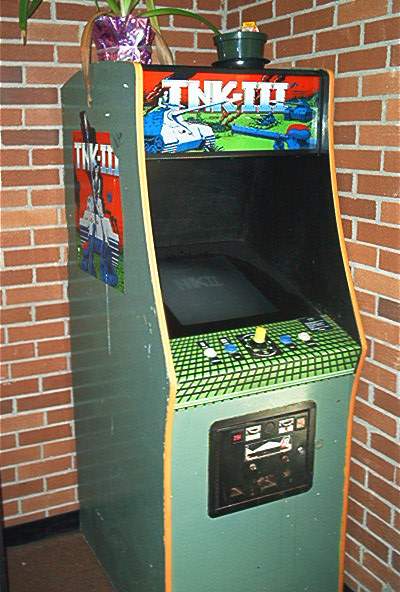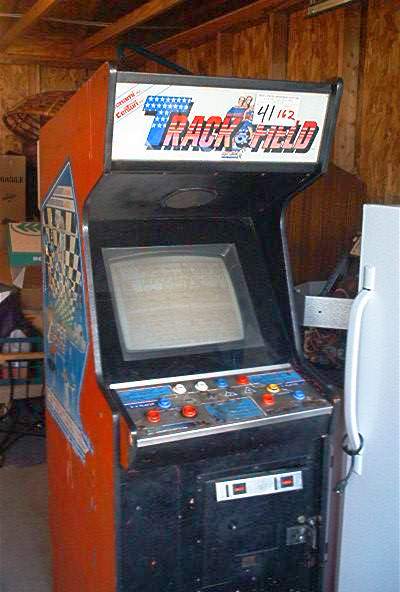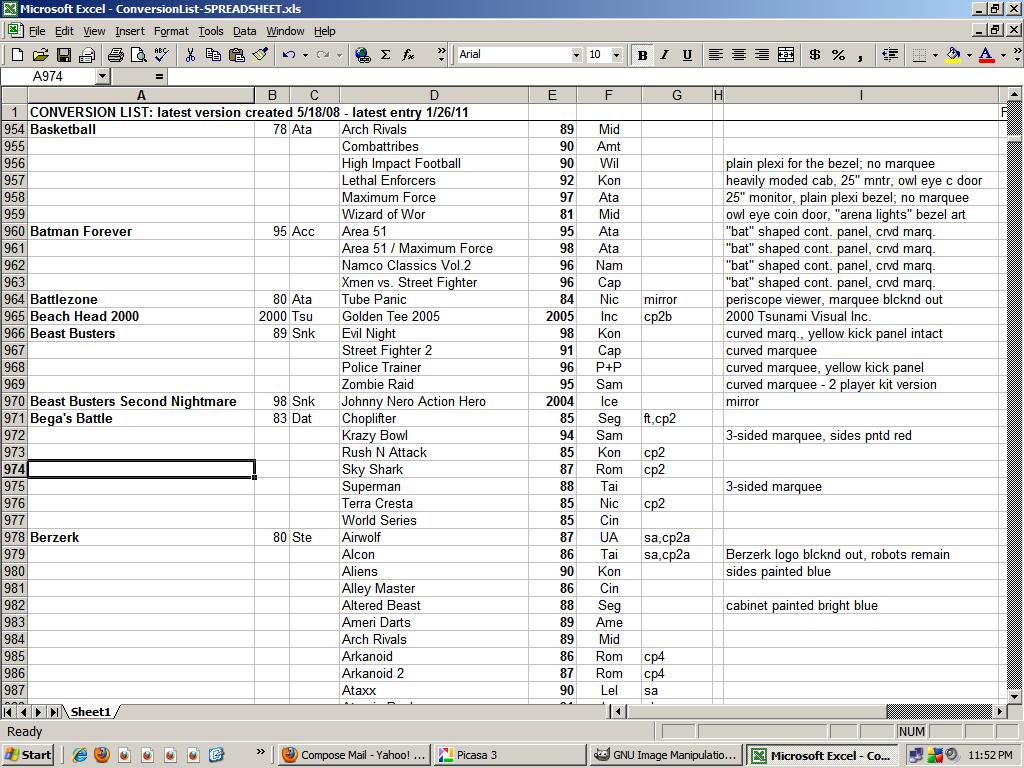My Conversion Education
Kyle Snyder
Let’s address a topic that tends to be rather polarizing among arcade video game collectors, specifically… conversions. Some collectors can imagine nothing worse than “soiling” their collection with a game installed in a converted cabinet, and they curse the creation of conversion kits altogether.
But yet other collectors have no such qualms, and they may have even built a conversion or two themselves. As for me, I have a unique fascination with converted cabinets and I’ve documented all that I’ve encountered for over 20 years. Here’s the story of “My Conversion Education”.
Detractors vs. Proponents
Detractors say that conversions caused the destruction of many classic arcade games. They lament all the Jousts, Tempests, and Q*Berts that ended up converted into “hot new” kit titles, many of which are viewed as having inferior gameplay when compared to the very games they replaced.
 Proponents point out that conversion kits actually extended the life of these same cabinets. Instead of sending that old Qix machine to the dump after it ran its course, an arcade operator could convert it into Ikari Warriors, for example, and it would continue to delight players for many years to come, albeit in a different guise.
Proponents point out that conversion kits actually extended the life of these same cabinets. Instead of sending that old Qix machine to the dump after it ran its course, an arcade operator could convert it into Ikari Warriors, for example, and it would continue to delight players for many years to come, albeit in a different guise.
Detractors groan about all the classic game marquees, bezels, control panels, monitors, and PCBs that were scrapped by some operators in order to prepare the older cabinet for the newer kit game. Proponents mention stories of collectors who found stockpiles of those very same classic game parts, ready to be used in restoration or repair projects, which were stashed away decades ago when the operators originally converted the machines.
I understand and respect both of those points of view. However, my unique fascination with conversions goes beyond that of most collectors and dates back almost 30 years, to when the first widely distributed conversion kits started appearing.
Arcade Cabinet Studies 101
When I was growing up, I didn’t just play the arcade classics, I studied them. While my folks grocery shopped or waited for the pizza to be delivered to our table, (and after I played any quarters burning a hole in my pocket), I spent my remaining time studying the cabinet artwork, the control panel layouts, the style of the coin doors, and the marvelous logos on the marquees. I even made mental notes of the shape and contours of the cabinets themselves.
When I returned home, I would quickly retreat to my room, crank up some top 40, and proceed to sketch the game cabinets, along with my best approximation of the appropriate artwork.
So imagine my surprise when my grandmother took me to an arcade in ’82 that featured an original Pac-Man cabinet sporting a Ms. Pac-Man marquee! I did a double take, as clearly my eyes were playing tricks on me. Then I looked on the screen and discovered it was actually PLAYING MS.PAC-MAN! I was completely captivated. Even though that arcade also had a few dedicated Pacs and Ms. Pacs, I just had to play this oddball machine. It was a truly surreal experience to be guiding Pac-Man’s wife through her bright peach colored maze, as the scowling blue ghost and smirking “Shmoo-like” Pac-Man looked on from the upper corners of the original Pac-Man bezel art. It’s just wasn’t RIGHT!
I rationalized that Midway probably had some excess Pac-Man cabinets sitting around the factory that they shipped out as Ms. Pac-Man, in order to use the older cabinets up. That explanation sufficed for about a year until I saw the next step in my education.
I visited a shopping mall that had an ice cream parlor. The parlor had a row of five or six games, backed up to the front windows. The cabinets were positioned in such a way that as you approached the parlor’s entrance, you would only see a row of back doors with the exception of the game sitting on the end of the row, on which you could see the complete right side panel. I immediately recognized the shape of a Defender, however, instead of the familiar artwork on the side, there was a single lightning bolt decal.
I was curious. As I entered the ice cream shop, and faced this cabinet I saw… TRACK & FIELD?!?!? Yep, this was unmistakably a Defender cabinet. It still had the Defender bezel, and that cool silver coin door, but it was playing Track & Field, and sported a T&F marquee and control panel overlay. This one really perplexed me. Centuri released Track & Field, not Williams, so how did this machine come to be?
Eventually I assumed that Centuri purchased some surplus Defender cabinets to install some of their Track & Field machines into. But even as a kid, I realized that this was much less likely than Midway using up old Pac-Man cabinets by releasing them as Ms. Pac. Finally, in 1985, all my questions were answered.
The fateful day at Time Out
 My grandfather took me to the Time Out arcade in Forest Village Park Mall. This was a regular haunt, visited almost every weekend that I would spend with my grandparents. I headed toward the Dig Dug machine, located in the back where the older “past their prime” games were located. Only on this visit, the game was pulled out from the wall at an odd angle, and a technician was poking around in the back of the cabinet.
My grandfather took me to the Time Out arcade in Forest Village Park Mall. This was a regular haunt, visited almost every weekend that I would spend with my grandparents. I headed toward the Dig Dug machine, located in the back where the older “past their prime” games were located. Only on this visit, the game was pulled out from the wall at an odd angle, and a technician was poking around in the back of the cabinet.
I approached this person, and asked if the game was broken. The technician leaned back out of the game and I was momentarily surprised to see a woman. Nearly every arcade employee I had ever noticed up until that point was a guy, so seeing a gal working on a game was an interesting change.
She was very amicable, and explained that she was installing a new game in the Dig Dug cabinet. She let me look in the back of the machine, and she pointed out the Dig Dug motherboard and the PCB for the new game, along with the power supply, and the back of the monitor. She talked to my grandfather and me for about 5 minutes until I went off to play some Spy Hunter.
When I returned the following weekend, I saw the new game… Konami’s Super Basketball. I tried it a few times, but it didn’t interest me as much as over-inflating Pookas and Fygars. Still, I was fascinated that an older game could be turned into a newer title. Those mysterious Ms. Pac and Track & Field machines I had seen several years prior suddenly made sense now. Once I understood conversions, I started noticing them everywhere. Mr. Do’s Castle in a Phoenix cabinet, Legend of Kage in a former Jungle King cab, Mania Challenge in a Zaxxon, Ghosts N Goblins in a Missile Command, Rush ‘N Attack in a Dragon’s Lair, and of course, all the Vs. Unisystem titles in earlier Nintendo cabs like Donkey Kong, and Popeye.
The list is born
Eventually, I began to compile an informal list of all the conversions I encountered. It began in a small black spiral notebook in 11th grade study hall, which would have been my 1989-1990 school year. Initially the list served only as a curious time waster, but I soon found that I simply couldn’t stop adding entries! The list soon outgrew the confines of the notebook, so I transferred the data into a spreadsheet program on an old NEC business computer that my uncle gave me.
Initially, I maintained two separate lists. The first was alphabetized according to the original game’s title, and the second was arranged by the title of the conversion kit installed. That way, I could either look up Centipede on the first list to find all the kits I’d seen installed in old Centipede cabinets, or I could visit the second list, and look up Ataxx to see all the earlier cabinets that had been converted into Leland’s 1990 strategy title. By the mid 90s, it became too labor intensive to maintain both lists, so I abandoned the kit variant, and continued on with the original cabinet game list only.
At first, I only noted conversions that I had personally encountered, but as street locations and arcades dwindled, I began to add machines I viewed online, typically on Ebay, other collector’s web pages, or in recent years, Craig’s List. Each unique conversion was only noted once. For instance, I’ve seen multiple Punch Out cabs converted into PlayChoice-10 machines, but it only appears as one entry in my list.
The list is broken into four overall sections, Uprights, Sit-Downs (Cockpits), Minis (Cabarets), and Cocktails & Countertops. Each section is arranged alphabetically by the name of the original machine, followed by the kit title several columns over. That way, I can go to the Sit-Downs section, scroll down to the “S”s for Star Rider, then look at “H” to find the entry for the Hydra machine I used to play at an arcade in Camp Springs, MD.
I also created a system of codes to note if the converted machine retained any artwork from the original game. For instance, “SA” designates “side art”, and “SH” stands for “screen shield art”, which was what I called bezels before I learned the proper term. Hey, the habit stuck.
To this day, I find that I can add several conversions a week to my list on the average. The oldest listed cabinets are a pair of Computer Space machines, one converted into a Pong clone, the other into a bootleg Pac-Man, and the newest converted cabinet is Global VR’s 2006 release Alien Extermination which I’ve seen converted into Paradise Lost, a later release from the same company. It’s hard to believe I’ve been keeping track of these things for over two decades, but if I didn’t do it, who would? Twenty-one years, seven moving days, eleven jobs, and countless computer upgrades later, and my conversion list, now in an Excel spreadsheet, currently features 16,645 individual entries.
Reflections…
I suppose I have a certain nameless female tech at Time Out to thank for all this. Had she not graciously taken a moment out of her day to explain the task at hand, and show me the inside of that Dig Dug cabinet, then perhaps I never would have cared about conversions.
I would’ve figured it all out by the late 80s anyway (at the latest), as I was collecting arcade flyers and old RePlay magazines by that time, many of which mentioned games being available in dedicated and kit form. But it’s true that the first impression really matters. So thank you, “Miss Time Out tech”, for answering the questions of an inquisitive 11-year old boy, who eventually used that knowledge to create a list that has made him smile well into his late 30s, and I’m sure will continue to do so as the years roll on.
 Kyle Snyder has written for Frank Polosky's Video Magic fanzine, Classic Gamer Magazine and then most recently for Gameroom Magazine. Kyle resides in Columbus, Ohio with his wonderful wife Michele and awesome five-year old stepson Zayne, both of whom are accomplished gamers in their own right. If you would like to know more about Kyle, read his full bio or drop him a line at hojoarcade36@yahoo.com. Want to write for Rotheblog.com? Contact us today.
Kyle Snyder has written for Frank Polosky's Video Magic fanzine, Classic Gamer Magazine and then most recently for Gameroom Magazine. Kyle resides in Columbus, Ohio with his wonderful wife Michele and awesome five-year old stepson Zayne, both of whom are accomplished gamers in their own right. If you would like to know more about Kyle, read his full bio or drop him a line at hojoarcade36@yahoo.com. Want to write for Rotheblog.com? Contact us today.
Here are some similar arcade posts
- Another poor converted Midway Mappy
- The History of Jr. Pac-man & it’s Sideart
- Dedicated Jr. Pac-man on Craigslist in AZ
- Finally got my ‘White’ Mr. Do!
- Scary ugly Galaga Conversion sold in Indianapolis for $170
If you enjoyed this post, please consider to leave a comment or subscribe to the feed and get future articles delivered to your feed reader.
Comments
Hi John, thanks for your kind feedback! It’s all about keeping the memories alive!
I remember reading an article in Electronic Games Magazine about arcades in Europe, and I was always fascinated with the photos. To my American eyes, I only recognized maybe 25% of the games in the European arcades (which were all Atari titles), because other games like Donkey Kong, Galaxian, and Pac-Man were in what were either “bootleg” cabs, or legitimate European cabinets I had never seen before.
I too loved the “street locations” as I didn’t get to visit actual arcades as much as I wanted. My folks and I used to visit “Marie’s Restaurant”, which in additional to serving outstanding beef stew and fried chicken, also had Space Duel, Frogger, and Carnival in the lobby. I was always equipped with quarters when we visited Marie’s.
Take care, John, and when you get the chance, check out my Lost Arcade Classics Facebook page and website!
http://www.facebook.com/home.php?sk=group_126698404034010&ap=1
Great article, Kyle.
I once had a Tron converted to Street Smart (a CRAP game if one ever existed) in the arcade that I took over in 2001. It even still had the artwork and black light below the control panel. I forgot what I did with it, but I do recall trading it to someone who was going to convert it back, as the sideart could be seen through the grey paint…
Leave a comment
Your email address is never displayed and cannot be spammed. If your comments are excessively self-promotional you will be banned from commenting. Read our comment privacy policy.





June 18, 2011
Kyle, I just wanted to say what an awesome article. Your passion is clear and I love that fact that you have kept your spreadsheet growing… 16,645 is an impressive number (I hope you keep a good back up)!
I’m from the UK but I’m a similar age to you, so your memories of those early arcade machines ring true with me. Once a week my family would go to a local Chinese takeaway, I didn’t care much for Chinese food back then, but they did amazing chips (or fries as you would call them). My main interest was playing the arcade machine, which was of course the classic Pac Man, and my dad used to keep me topped up with change to play it whilst we waited for our order.
Thanks for your great article and for bringing back fond memories. Keep it up!